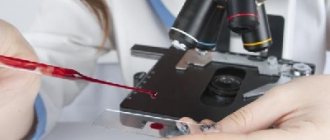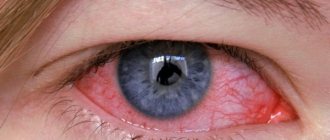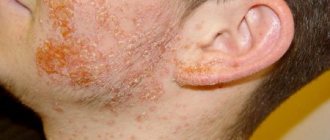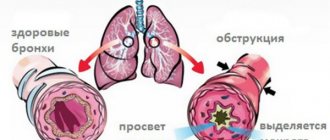The inflammatory process of the appendix is a fairly common phenomenon, and the disease can be treated in only one way - surgical excision of the appendix. That is why The disease should be identified quickly and immediately consult a doctor – progression of inflammation can lead to penetration of pus into the peritoneum, which is very life-threatening. Many parents who know about the dangers of the disease are interested in how to recognize appendicitis, symptoms in children, which side of appendicitis is on, in what cases should you consult a doctor?
Typical symptoms of the inflammatory process in children
An attack of acute appendicitis in children begins suddenly and develops rapidly, and the first symptoms appear approximately 4 hours after the onset of the pathological process, reaching maximum intensity after 6-8 hours. In order to provide the child with the necessary help in a timely manner, parents must know the clinical picture of the disease, as well as the basics of differential diagnosis, because at the initial stage (catarrhal stage) the disease can be confused with other diseases of the gastrointestinal tract and abdominal organs.
Nausea and vomiting
Nausea appears within about 2 hours after the onset of inflammation. The child becomes lethargic, capricious, and refuses to eat. Appendicitis is characterized by wave-like occurrence of attacks of nausea, that is, it may subside for a short time, and then appear again, taking a more intense course. Vomiting in this disease may be absent, but a single release of vomit is possible, which is the result of acute intoxication.
Nausea and vomiting are one of the symptoms of appendicitis inflammation
Note! If a child has repeated and profuse vomiting, a high fever, and complains of severe abdominal pain, the most likely cause is an intestinal infection, poisoning, or intestinal flu.
Coated tongue
A fairly typical sign for acute or chronic inflammation of the appendix. The plaque usually appears only on the surface of the tongue and is a gray, beige or milky mass of dense texture, difficult to remove with a spoon or a special spatula. Sometimes children develop plaque in the form of small dense lumps. There is usually no bad breath - this sign can be used to distinguish appendicitis from diseases of the digestive system: pancreatitis, esophagitis, gastritis.
Plaque on the tongue with appendicitis
Temperature
The catarrhal stage of appendicitis can occur without fever, but many children experience slight fluctuations within the subfebrile range (up to 38°). The temperature rises above this limit when the pathology enters the phlegmonous stage, in which all layers of the appendix are involved in the pathological process, and the production of purulent exudate begins.
Important! A temperature of 38.5° (rarely 39° and above) is typical for children aged 3 to 8 years. Older children and adolescents tolerate the disease a little easier, but even in them, phlegmonous and gangrenous appendicitis occurs when the temperature exceeds the boundaries of subfebrile values.
Changing the stool
In approximately 15% of adolescents, appendicitis begins with acute diarrhea. This sign may be one of the first, before the appearance of pain, nausea and other clinical manifestations of the inflammatory process. Stool with appendicitis is frequent, profuse, has a watery or mucous consistency and is light yellow in color. There is usually no putrid or pungent odor; pieces of poorly digested or undigested food may be present in the stool.
Stool with appendicitis is frequent and abundant
In children under five years of age, digestive disorders most often manifest themselves as constipation. Constipation usually occurs 2-3 days before the onset of an attack, and during acute inflammation the child experiences intense pain when trying to empty the intestines.
Important ! Pain with appendicitis occurs not only during bowel movements, but also during urination. If a child complains of pain when going to the toilet, combined with abdominal pain and a rising temperature, it is necessary to exclude the possibility of catarrhal or phlegmonous appendicitis.
Forecast
With timely diagnosis and surgical treatment, the prognosis for the child’s health and life is favorable. It worsens with delay (for example, too long a wait-and-see approach, which is followed by young, inexperienced surgeons, underestimating the existing clinical picture). Also, the prognosis sharply worsens when parents try to treat the child at home. This cannot be done. Particularly pronounced negative consequences can be caused by applying a warm or hot heating pad to the area of pain in the abdomen.
Kovtonyuk Oksana Vladimirovna, medical observer, surgeon, consultant doctor
8, total, today
( 158 votes, average: 4.66 out of 5)
Laparoscopy: what is it, pros and cons of abdominal laparoscopy
Symptoms and treatment of peritonitis
Related Posts
Pain syndrome: nature, localization, intensity
Pain during inflammation of the appendix usually has a clear location - on the right side just above the umbilical line. With the rapid development of inflammation and accumulation of pus, pain can radiate to the limbs, shoulder blade, arm or the area where the diaphragmatic tube is located.
Primary pain in appendicitis
Pain syndrome may be accompanied by the following symptoms typical of inflammation of the appendix in children and adolescents:
- abdominal asymmetry;
- abdominal muscle tension;
- retraction and depression of the abdominal wall;
- swelling of the abdomen.
At the beginning of an attack, painful sensations can be concentrated in the epigastric region - the space located under the xiphoid process and the corresponding projection on the anterior wall of the peritoneum. Within 6-12 hours, the pain descends to the abdominal region and takes on a clear localization, and the place of maximum pain may be behind the rectum, deep in the pelvic space or closer to the central (midline) line of the abdomen.
The nature of the pain may vary. At the catarrhal stage of the pathological process, the child is usually bothered by sharp, stabbing or cutting pains. After the transition to the phlegmonous stage, the pain usually takes on an aching course with periods of exacerbation.
Locations of pain in appendicitis
Important ! A typical symptom of appendicitis in children of any age is increased discomfort and discomfort when lying on the left side, especially if the patient straightens his knees and stretches them forward. To relieve pain, the child lies primarily on the right side, taking the fetal position (with legs pulled up and bent).
Female characteristics
Laroca. Its essence lies in the fact that when the male appendix becomes inflamed, a spontaneous displacement of the right testicle in the upper direction is observed.
Horna. If the scrotum is pressed or twitched, then pain of varying intensity is felt in the right testicle.
Britten. To identify it, you need to press your hand from the lower abdomen with tense muscles in this area. As a result of the test, the right testicle rises, but after removing the hand it returns to its place.
In female representatives, specific signs of appendicitis can also be identified. They should be taken into account, because inflammation of the appendix in some cases is very similar to the manifestation of certain gynecological diseases. Additional testing helps differentiate the pathology in question from other female problems.
Promptova. The gynecologist, conducting examinations of the vagina, moves the cervix back and forth. The appearance of pain excludes the presence of appendicitis and indicates a gynecological disease.
Zhendrinsky. The test is carried out by pressing a finger on the point located below the navel, i.e. Kümmel point. Pain syndrome appears. If the pain intensifies when standing up, appendicitis may be suspected. When the pain subsides, gynecological causes should be sought.
Brando. In women during pregnancy, pressing on a rib on the left side of the body causes a painful sensation on the right side.
How to recognize a seizure in children under 3 years of age?
Diagnosing acute appendicitis in children of this age group is a very difficult task. It is almost impossible to determine an attack at an early stage due to a blurred clinical picture and the impossibility of collecting a complete history, since children of primary preschool age cannot tell in detail what is bothering them and accurately indicate the location of the pain syndrome.
Signs of inflammation of the appendix in young children include:
- acute diarrhea;
- temperature increase;
- dryness of the oral mucosa;
- pale skin;
- vomiting
Symptoms of appendicitis in young children
Unlike older children and teenagers, children under three years of age usually vomit repeatedly and profusely. This is associated with severe intoxication and rapid deterioration in health. Parents should know that frequent vomiting leads to dehydration, so if a child complains of abdominal pain, which is combined with vomiting and a general deterioration in health, you should immediately consult a doctor. If vomiting occurs more than 2-3 times per hour, you should immediately call an ambulance or transport the child to a surgical hospital.
The body temperature of patients in this age group rises to high levels - 39° and above. Fever, chills and other manifestations of intoxication by themselves do not indicate appendicitis, but in combination with the symptom complex of “acute abdomen” they should be a reason for immediate consultation with a doctor and diagnostic measures.
Tests for diagnosing appendicitis in children
To clarify the clinical picture of the disease and diagnose inflammatory processes in the abdominal cavity, doctors use special tests to identify additional symptoms that children cannot always describe on their own. These methods are quite effective and informative, but only an experienced doctor who knows the technique of palpation and percussion of the abdomen can conduct such studies correctly.
Causes of appendicitis in children
| Test name | Characteristics and description |
| Dumbadze's symptom | When palpating the abdomen in the area of the umbilical line, a sharp or stabbing pain is detected in the center or around the umbilical ring. In some cases, irradiation may be observed in the area between the shoulder blades and the diaphragm area |
| Obraztsov's symptom | The child must be placed in a horizontal position and the abdomen should be palpated with the right leg raised up. With appendicitis, the pain syndrome will increase in the place of maximum localization of painful sensations |
| Shchetkin-Blumberg symptom | This is one of the most popular methods for diagnosing acute appendicitis, which should only be performed by a doctor, since inept actions can cause harm to the child. The patient should be placed on a hard surface (there is no need to place a pillow or cushion under the head), press on the central part of the abdomen and the navel area with two fingers, and then sharply remove the hand. When inflammation of the appendix worsens, the patient will feel a sharp pain |
| Sitkovsky's symptom | Manifested by increased pain when lying on the left side |
| Voskresensky's symptom | The edge of the palm must be quickly passed along the right side, starting from the lower border of the ribs, without removing the child’s clothes. If the deterioration in health is caused by inflammation of the appendix, during this test the child will feel increased pain |
Additional diagnostic methods include laboratory testing of blood and urine with determination of the leukocyte formula of the blood, coprogram, and stool testing for pathogenic flora. Of the hardware and instrumental methods, ultrasound diagnostics, radiography and computed tomography are used. For the purpose of differential diagnosis of some intestinal diseases, rectal examination of the rectum using a finger can be used.
Progression of appendicitis
Important! If purulent forms of appendicitis (phlegmonous or gangrenous) are suspected, for the purpose of diagnosis and treatment, the child may be prescribed diagnostic laparoscopy - a method of examining the abdominal cavity using a laparoscope, which is inserted through small round holes in the abdomen.
Why does the problem occur?
What is appendicitis?
This concept implies the development of an inflammatory reaction in the appendix, which is a vermiform appendix. The progression of this process is fraught with great trouble, even death. Taking this into account, the issue of accurately assessing the severity of inflammation and the accuracy of diagnosis often becomes the most important factor in preventing tragic consequences. With appendicitis, the manifestation of characteristic signs is associated with the spread of inflammation into the deep layers and coverage of surrounding structures. Symptoms can be varied, and accurate diagnosis is complicated by the fact that the disease can be easily confused with other pathologies of internal organs.
That is why several options for determining diagnostic parameters have been proposed to differentiate appendicitis and timely detection. Accordingly, such a concept as symptoms according to the authors appeared, i.e. qualifying signs that certain researchers propose to use as defining ones (for example, the Voskresensky symptom, Shchetkin-Blumberg, etc.).
All signs of appendicitis essentially fall into four main categories: pain, signs of inflammation, dyspeptic and peritoneal manifestations. The intensity of symptoms depends on the location of the process, the duration of development of the process, the characteristics of the organism, the severity of the course and the presence of complicating factors.
Why are the author's symptoms of the disease needed? They are, first of all, aimed at making a primary diagnosis based on external signs and behavior of the sick person. The basis is an external examination and elementary manipulations (palpation, pressing, etc.), carried out in various artificially created conditions and poses.
What should parents do?
The biggest mistake that parents make when they discover that their child has a stomach ache is the use of antispasmodic and painkillers to relieve unpleasant symptoms. Such actions can lead to a distortion of the clinical picture of the disease and an incorrect diagnosis, as a result of which the child will not be able to receive the necessary medical care (most often, emergency care). Even a few hours with acute purulent appendicitis can cost the child’s life, since if the appendix ruptures and purulent exudate enters the peritoneal cavity, deadly conditions quickly develop - peritonitis and sepsis.
First aid for exacerbation of appendicitis
In order to prevent the child’s well-being from deteriorating, parents should know what should never be done before the patient is examined by a doctor. Before the ambulance arrives, it is strictly prohibited:
- give the child food and drinks (if you are very thirsty, you can give a teaspoon of water - no more than once every 15 minutes);
- take painkillers, antispasmodics, antiemetics and any other medications (except for vital medications, if prescribed by your doctor);
- place a heating pad on the stomach (heat in a purulent form can provoke increased inflammation and cause a rupture of the appendix);
- massage the abdomen, trying to reduce the intensity of pain.
It is best to place the child on his right side - in this position the pain syndrome weakens slightly, allowing you to wait for the medical team to arrive without the use of analgesics. Any physical activity should be avoided.
Video - Appendicitis in children
Appendicitis is a dangerous disease at any age, but the risk in children is several times greater than the risk of complications in adult patients. Mortality from acute inflammation of the appendix and purulent peritonitis increases by approximately 1.7% every decade, so there is no need to risk children's health, and if alarming symptoms appear, you should immediately seek medical help. Read on our website how long it takes to remove appendicitis.










